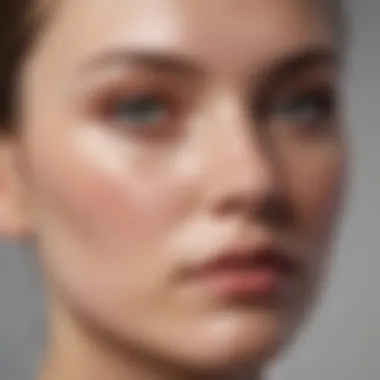Unveiling the Myriad Factors Behind Forehead Acne Development


Fashion Trends and Must-Have Pieces
In the realm of skincare, understanding the root causes of forehead acne is akin to deciphering a complex fashion trend - multi-faceted and ever-evolving. Just as runway reports dictate the latest must-have pieces, an analysis of genetic predispositions, lifestyle choices, and skincare practices reveals why acne tends to manifest prominently on the forehead. This exploration delves deep into the intricate interplay of internal and external factors that contribute to this common skin condition.
Skincare Routines
Delving further into the world of skincare routines unveils a crucial aspect of combating forehead acne. Just as one carefully curates their wardrobe with seasonal must-haves, establishing a personalized skincare regimen is essential in addressing acne issues. From understanding the importance of gentle cleansing to the role of exfoliation in unclogging pores, each step in a well-rounded routine holds significance in maintaining clear and healthy skin. By incorporating effective products and techniques, individuals can navigate the turbulent waters of acne-prone skin with confidence and awareness. Detailed guidance on product selection, application methods, and expert insights further enrich this narrative, delivering valuable knowledge for readers of all ages.
Celebrity Fashion Spotlights
Much like dissecting the red carpet looks of celebrities, scrutinizing the genetic predispositions towards acne offers valuable insights into its development. Just as style breakdowns reveal the meticulous planning behind a celebrity's ensemble, a closer look at familial tendencies sheds light on one's predisposition to skin issues. By unraveling the genetic puzzle behind acne, individuals can equip themselves with the knowledge needed to make informed decisions regarding their skincare routines and lifestyle choices. This section blends scientific research with practical advice, offering a comprehensive overview of how genetic factors influence the occurrence of forehead acne.
Fashion Week Updates
Transitioning into the domain of skincare innovations is akin to keeping abreast of the latest industry news and events in the fashion world. Just as fashion week updates signal the arrival of revolutionary trends, advancements in skincare technologies herald new possibilities in acne treatment. From product launches featuring cutting-edge ingredients to industry insider insights on upcoming breakthroughs, staying informed is paramount in navigating the vast landscape of skincare solutions. By exploring the dynamic nature of acne treatments and innovations, readers can empower themselves with the knowledge needed to address their skin concerns effectively and proactively.
Introduction
In this insightful article aimed at unraveling the mysterious realm of forehead acne, we embark on a journey to unravel the underlying causes that lead to this common skincare woe. Acne, an age-old skin condition, continues to perplex many individuals, impacting not only their physical appearance but also their self-esteem. By shedding light on the triggers of acne specifically manifesting on the forehead, we aim to provide a nuanced perspective that merges scientific understanding with practical solutions. This section serves as a stepping stone towards comprehending the complexities of acne development while paving the way for informed choices in skincare routines and lifestyle habits.
Defining Forehead Acne
The focal point of this segment centers on grasping a clear understanding of forehead acne, distinct from acne occurring on other facial regions. Forehead acne, characterized by its localization on the top half of the face, presents unique challenges and considerations in terms of management and prevention. Delving deeper into the specifics of this acne variant, we aim to decode the science behind its occurrence, exploring factors such as sebum production, pore congestion, and bacterial influence. By unraveling the distinct characteristics and triggers of forehead acne, readers can cultivate a more informed approach to skincare tailored to address this specific concern.
Genetic Factors


In understanding the causes of forehead acne, genetic factors play a pivotal role that cannot be overlooked. Our genetic makeup significantly influences the propensity to develop acne on the forehead. The heritability of acne-prone skin is a crucial aspect to consider. Individuals with a family history of acne are more likely to experience similar skin conditions due to shared genetic traits. These genetic predispositions not only dictate the skin's natural oil production but also impact its sensitivity to external factors. By exploring the genetic factors contributing to forehead acne, we can unravel the intricate interplay between inherited characteristics and environmental influences.
Inheritance of Acne-prone Skin
The inheritance of acne-prone skin is a key determinant in the development of acne on the forehead. Genes passed down from parents can influence sebum production, skin cell turnover rates, and inflammatory responses, all of which contribute to acne formation. While genetic predispositions alone may not guarantee acne development, they create a foundation that, when combined with environmental factors, can increase the likelihood of skin issues. Understanding the inheritance of acne-prone skin sheds light on why some individuals are more prone to forehead acne than others, highlighting the need for personalized skincare approaches based on genetic backgrounds.
Role of Hormones
Hormones play a vital role in regulating sebum production, a key factor in the onset of acne. Fluctuations in hormone levels, particularly androgens like testosterone, can stimulate the sebaceous glands to produce excess oil. This overproduction of sebum can clog pores, leading to the development of acne lesions on the forehead. Hormonal imbalances, often experienced during puberty, menstruation, pregnancy, or menopause, can exacerbate acne symptoms. Understanding the intricate relationship between hormones and sebum production is essential in managing and preventing forehead acne outbreaks.
Effect on Sebum Production
One of the critical impacts of hormones on acne development is their effect on sebum production. Androgens stimulate the sebaceous glands to produce more oil, leading to increased sebum secretion. This excess oil mixes with dead skin cells and bacteria, forming a breeding ground for acne-causing bacteria. The heightened sebum production not only contributes to clogged pores but also creates an ideal environment for acne bacteria to thrive. Balancing hormone levels to regulate sebum production is crucial in controlling forehead acne, emphasizing the significance of hormonal management in skincare routines.
Skincare Routine
Skincare routine plays a crucial role in understanding and managing forehead acne. It encompasses various elements that can significantly impact the skin's health, including cleansing habits and moisturizer selection. By establishing a consistent and effective skincare routine, individuals can mitigate the factors that contribute to acne development.
Impact of Cleansing Habits
Cleansing habits form the foundation of a proper skincare routine, with the choice of products and techniques influencing the skin's balance and clarity. One specific aspect that deserves attention is the use of harsh ingredients in cleansers. These abrasive components can strip the skin of its natural oils, leading to increased sebum production and potential acne breakouts. While harsh ingredients may provide a deep cleaning sensation, they can compromise the skin's barrier function and aggravate existing skin conditions, such as acne.
Use of Harsh Ingredients
The emphasis on using harsh ingredients in cleansing products often stems from a desire for a thorough cleansing experience. Unfortunately, the use of such ingredients can disrupt the skin's p H balance, causing irritation and inflammation. Harsh ingredients like sulfates and alcohol may give a temporary sensation of cleanliness, but their long-term effects can be detrimental, especially for individuals prone to acne. It is essential to identify gentler alternatives that cleanse effectively without causing harm to the skin's natural protective barrier.
Moisturizer Selection


Alongside cleansing habits, moisturizer selection is another vital aspect of a skincare routine aimed at preventing forehead acne. Choosing non-comedogenic products can significantly impact the skin's health by ensuring that the moisturizer does not clog pores or contribute to acne formation. By opting for non-comedogenic formulations, individuals can hydrate their skin effectively without risking pore blockages and subsequent breakouts.
Choosing Non-comedogenic Products
The importance of selecting non-comedogenic moisturizers lies in their ability to maintain skin hydration without exacerbating acne. These products are specifically designed to be non-pore-clogging, reducing the likelihood of comedones and blemishes. Non-comedogenic formulations typically contain lighter textures that absorb easily into the skin without leaving a greasy residue. By prioritizing non-comedogenic products, individuals can ensure that their skincare routine promotes skin health and helps prevent the occurrence of forehead acne.
Diet and Lifestyle
In the exploration of the causes of forehead acne, the section on Diet and Lifestyle stands out as a crucial aspect influencing skin health. Our dietary choices and daily habits play a significant role in the development and aggravation of acne on the forehead. Understanding the relationship between what we eat and how we live with the occurrence of acne is key to adapting a holistic approach towards skincare.
When delving into the impact of Diet and Lifestyle on forehead acne, it becomes evident that certain dietary factors, including the consumption of high glycemic index foods, can trigger acne breakouts. High glycemic index foods like sugary snacks, processed foods, and refined carbohydrates lead to rapid spikes in blood sugar levels, subsequently causing inflammation and increased sebum production in the skin – ultimately contributing to acne development.
Moreover, stress, a prevalent component of modern lifestyle, is another significant factor closely linked to acne formation. The body's response to stress prompts the release of cortisol, commonly known as the stress hormone, which can stimulate the oil glands in the skin to produce more sebum. Excess sebum production, combined with the inflammatory response triggered by stress, creates a favorable environment for acne to thrive, particularly on the forehead.
As individuals navigate the complexities of maintaining clear and healthy skin, paying attention to their diet and lifestyle choices becomes paramount in managing and preventing forehead acne. By making informed decisions regarding food consumption and stress management, individuals can empower themselves to tackle acne at its root, promoting long-term skin health and well-being.
Haircare Practices
Haircare practices play a vital role in understanding and addressing the complex issue of forehead acne in this insightful article. This section offers a detailed examination of how haircare practices directly impact the occurrence and intensity of acne on the forehead. By delving deep into the intricacies of haircare routines, readers can grasp the connections between hair products, washing frequency, and skin health. Furthermore, emphasizing the significance of maintaining a proper haircare regimen is essential for mitigating potential triggers of forehead acne.
Use of Hair Products
Effect of Residue on Forehead
The effect of residue from hair products on the forehead is a critical aspect that significantly influences acne development and persistence. Residue from hair products can contain a multitude of ingredients that may interact with the skin on the forehead, leading to clogged pores and subsequent acne breakouts. The key characteristic of this residue is its ability to transfer oils, chemicals, and particles onto the skin, creating a breeding ground for acne-causing bacteria. Understanding how residue from styling products or shampoos can seep onto the forehead helps in comprehending the root causes of acne in this area. While residue may offer styling benefits, its presence on the forehead can exacerbate existing skin conditions, making it imperative to thoroughly cleanse the skin to remove any lingering residues. Recognizing the negative implications of residue on the forehead underscores the need for mindful selection and application of hair products to prevent unwarranted skin reactions.


Frequency of Hair Wash
Discussing the frequency of hair washing sheds light on another pivotal factor in managing forehead acne. The frequency at which individuals wash their hair directly impacts the level of residue buildup on the scalp and subsequent transfer to the forehead. Finding the optimal balance between maintaining scalp health and minimizing skin exposure to residue requires a tailored approach based on hair type and lifestyle factors. Addressing the frequency of hair wash in the context of forehead acne elucidates how personal care habits can either alleviate or exacerbate skin conditions. By exploring the implications of infrequent or excessive hair washing on forehead health, individuals can adjust their routines to promote clearer skin and prevent acne flare-ups.
Environmental Factors
Humidity and Sweat
Humidity and sweat are two environmental factors that can exacerbate the occurrence of forehead acne. In regions with high humidity levels, the excess moisture in the air can lead to clogged pores and increased sebum production. Sweating, whether due to hot weather or physical activity, can also contribute to the accumulation of impurities on the skin's surface. The combination of humidity and sweat creates an ideal environment for bacteria to thrive, potentially leading to inflammation and acne breakouts on the forehead. To combat the adverse effects of humidity and sweat, individuals should consider adjusting their skincare routine to include products that help regulate oil production and maintain skin hydration.
Pollution and Toxins
In today's urbanized world, exposure to pollution and toxins is almost unavoidable. These environmental aggressors pose a significant threat to skin health, including the development of acne on the forehead. Pollution particles can penetrate the skin's barrier, causing inflammation and oxidative stress. Air pollution, such as vehicular emissions and industrial fumes, can clog pores and impede the skin's natural detoxification process. Toxins from various sources, including household cleaners and personal care products, can also contribute to skin irritation and acne flare-ups. Combatting the effects of pollution and toxins involves adopting a diligent skincare regimen that includes cleansing the skin thoroughly to remove impurities and using antioxidant-rich products to protect against environmental damage.
Medical Conditions
When delving into the multifaceted realm of acne causation, the section on Medical Conditions serves as a crucial anchor. Understanding the interplay between specific health issues and the development of forehead acne is paramount in unraveling the complex tapestry of dermatological concerns. In this article, the focus lies on elucidating how underlying medical conditions can significantly influence the emergence and persistence of acne on the forehead. By shedding light on this aspect, readers can grasp the intricate connections between their overall health and skin wellness, offering a holistic perspective on skincare management and treatment strategies.
Impact of Certain Health Issues
Presence of PCOS
A noteworthy facet within the realm of medical conditions contributing to forehead acne is the Presence of PCOS or Polycystic Ovary Syndrome. This hormonal disorder can wield a substantial impact on skin health, particularly in precipitating acne outbreaks on the forehead. The key characteristic of PCOS lies in its disruption of hormonal balance, leading to heightened androgen levels that instigate excessive oil production in the skin's sebaceous glands. In the context of this article, the discussion around the Presence of PCOS underscores its pivotal role in exacerbating acne issues, emphasizing the need for tailored skincare approaches to mitigate its deleterious effects effectively. By shedding light on the unique features of PCOS and its implications for acne development, readers can grasp the intricate dynamics between hormonal disorders and dermatological manifestations, fostering a nuanced understanding of acne etiology within the broader landscape of medical conditions.
Conclusion
In this comprehensive exploration of the causes of forehead acne, the Conclusion section serves as the pinnacle of understanding the complexity surrounding this common skin issue. By synthesizing the intricate web of genetic, lifestyle, skincare, and environmental factors discussed in previous sections, the Conclusion cements the importance of holistic care in managing and preventing forehead acne. It is crucial to acknowledge that forehead acne is not merely a superficial concern but a reflection of deeper imbalances within the body. By addressing the root causes highlighted throughout this article, individuals can embark on a journey towards clearer and healthier skin.
Furthermore, the Conclusion reaffirms the significance of personalized approaches to skincare. Recognizing that each individual's skin is unique, the Conclusion emphasizes the need to tailor skincare routines and lifestyle choices to one's specific needs and concerns. Through a nuanced understanding of the diverse factors contributing to forehead acne, readers are empowered to make informed decisions that align with their skin's requirements.
Moreover, the Conclusion underscores the interplay between internal and external factors in the development of forehead acne. By shedding light on the interconnectedness of genetics, hormones, diet, stress, haircare, environmental triggers, and underlying health conditions, the Conclusion underscores the multifaceted nature of acne on the forehead. It prompts readers to adopt a holistic perspective towards skincare, viewing it as a blend of science, self-care, and self-discovery.
Ultimately, the Conclusion encapsulates the essence of this article by highlighting the importance of proactive and preventive measures in addressing forehead acne. Rather than resorting to quick fixes or superficial treatments, individuals are encouraged to delve deep into their skin's needs and make sustainable changes that promote long-term skin health. As the concluding chapter of this exploration, the Conclusion leaves readers with a sense of empowerment and insight, equipping them with the knowledge needed to navigate the realm of forehead acne with confidence and clarity.







